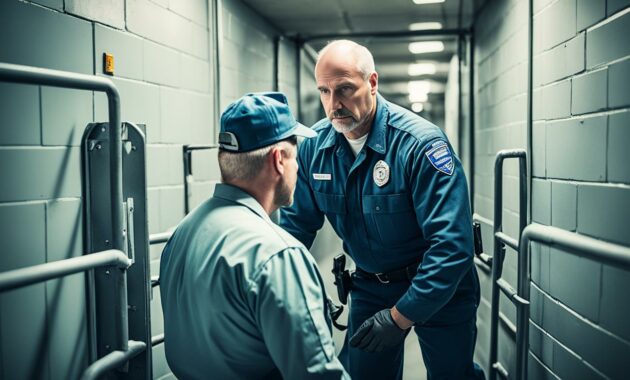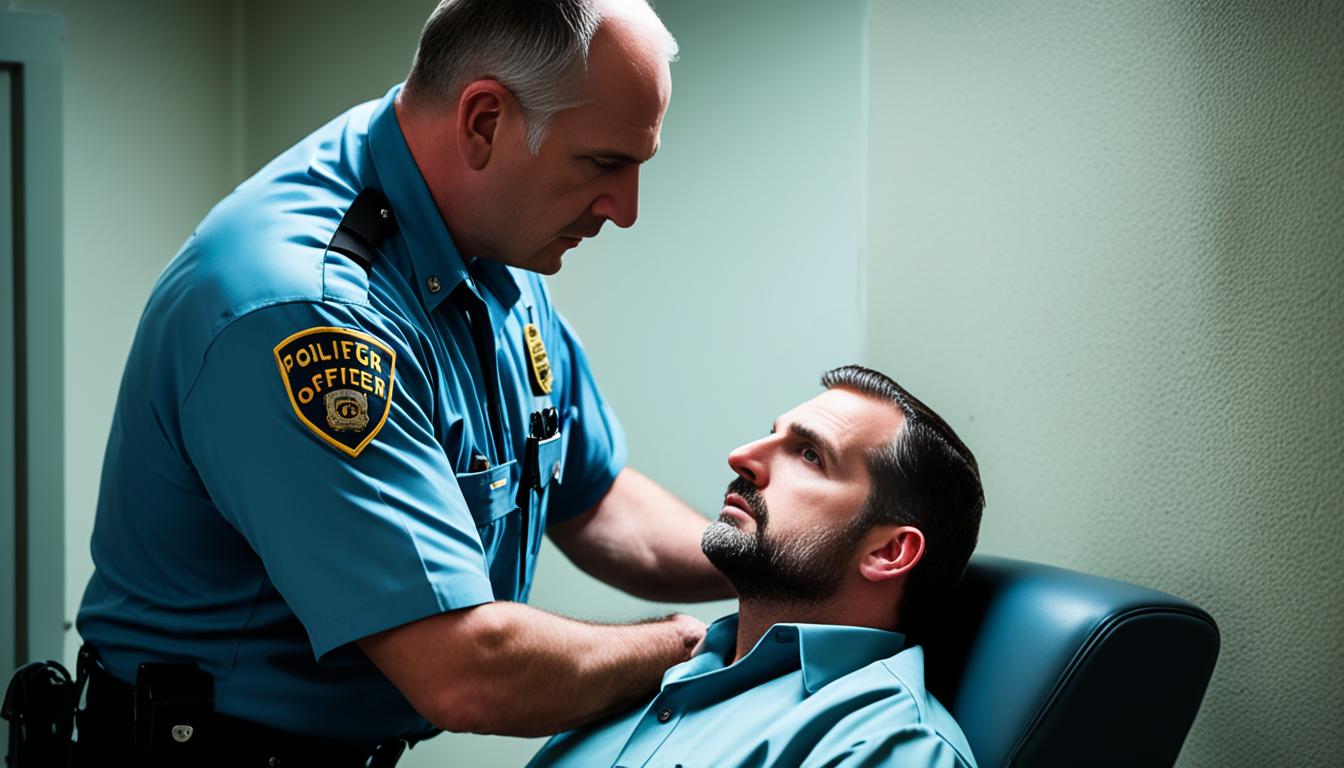This article dives into the key regulations in 28 CFR § 552.12. These rules are vital for keeping inmates safe in jails across the U.S. We will look at how the guidelines cover close observation. It includes when and how to watch inmates closely, what to look for, and how to document everything. This helps understand when and how to stop close observation too. We’ll also see how tech tools help study these rules and their impact on jail safety.
The safety of inmates in the correctional system relies heavily on the rules in 28 CFR § 552.12. By knowing these rules, people working in jails can keep a better eye on those who might hurt themselves. This knowledge can lower the risks of self-harm and suicide among inmates.
Introduction to 28 CFR § 552.12
28 CFR § 552.12, or the “Close Observation Regulations,” discusses how to monitor inmates in jails closely. This rule offers a detailed plan to watch over inmates who might hurt themselves. It aims to keep everyone in jail safe and healthy.
Overview of Close Observation Regulations
The close observation rules in 28 CFR § 552.12 are important for managing inmates needing more attention. It includes:
- Why and how a person is put under close watch, especially focusing on mental health and suicide risks.
- What staff must do to keep track of these inmates, and how they should record everything during this time.
- When and how the observation status can change, needing the Warden’s approval.
- The steps and rules for searching to keep dangerous items out of the jail.
It’s key to know these rules to ensure jails are safe and run smoothly. This is for the well-being of those inside and the facility’s security.
In following 28 CFR § 552.12, jails aim to respect inmates’ rights while keeping things safe and in order. These rules help staff watch over potentially at-risk inmates better. This contributes to a better, safer place for all.
Applicability and Scope of 552.12
The rules set in 28 CFR § 552.12 are for all US federal prisons. These guidelines help officers spot and work with inmates who might hurt themselves or others. The aim is to stop self-harm and make the jail safer for everyone.
552.12 covers how to decide if an inmate needs extra watching. It details what to do and what to write down while watching them. This system makes sure jails all follow the same careful watching rules, aiding both inmates and jail workers.
- The regulation applies to all federal correctional facilities and institutions operated by the Bureau of Prisons.
- It establishes a standardized approach to identifying and managing inmates who may pose a risk to themselves or others.
- The scope of 552.12 includes the criteria for placing an inmate under close observation, the specific procedures to be followed, and the documentation requirements.
- The goal is to prevent self-harm and promote the overall safety and security of the correctional environment.
Following 28 CFR § 552.12 ensures federal correctional facilities keep a steady watch on things. This means all inmates and workers are safer and better off.
Criteria for Placing Inmates on Close Observation
Inmates might be put on close watch, also called “dry cell” status. This is because they show signs they might hurt themselves or have mental health problems. The prison staff has to look at each inmate’s situation closely to get this right. They decide how much they need to watch them.
Mental Health and Suicide Risk Factors
The rules say it’s important to check if an inmate might be thinking of suicide. They look at things like:
- If there’s a sign the inmate is struggling or thinking about killing themselves.
- If an inmate has done things that could hurt them.
- If they’ve hurt themselves before or tried to kill themselves.
- If experts or other staff say they’re worried about the inmate.
Prison staff get trained to spot these signs. They look for things like feeling very sad, using drugs before, or going through tough times recently. This helps make sure they put the right inmates on close watch.
“The decision to place an inmate on close observation is determined on an individual basis, with the length of close observation status typically involving supervision for up to three days, but can be extended with the approval of the Warden, which is decided in consultation with the Captain and qualified health personnel.”
By checking carefully for signs of suicide and using the right rules, prisons can help keep inmates safe from hurting themselves.
Procedures for Close Observation
An inmate under close observation is watched all the time. This is to keep them safe. The rules for this are listed in the 28 CFR § 552.12. They need to be watched without a break by trained staff.
Monitoring Requirements and Documentation
The rules say that keeping careful notes and talking with mental health experts is key. Everything about the inmate’s actions and changes in how they act must be written down. Mental health professionals must check on the inmate often to see if they still need to be watched closely.
To protect the inmate, dangerous things are taken away in the room where they are watched. The staff watching them must be the same gender. Inmates can’t have their personal belongings, except for mail. They may also not get to leave their room for activities for everyone’s safety.
- Continuous, direct, and uninterrupted visual monitoring of the inmate by trained correctional staff
- Detailed documentation of all interactions and changes in behavior
- Regular checks by mental health professionals to see if the inmate still needs close watching
- Specific rules to keep the inmate safe, like taking away dangerous items
- The staff watching must be the same sex as the inmate
- Inmates aren’t allowed to keep most personal items in the room but can have mail
- They might not be allowed out of their room for common activities for safety reasons
| Procedure | Requirement |
|---|---|
| Inmate Monitoring | Continuous, direct, and uninterrupted visual monitoring by trained correctional staff |
| Documentation | Detailed records of all observations, interactions, and changes in the inmate’s condition |
| Assessments | Regular evaluations by mental health professionals to determine ongoing risk and need for continued observation |
| Safety Protocols | Removal of potentially dangerous items from the observation cell |
| Staffing | Supervising staff member must be the same sex as the inmate and maintain constant visual supervision |
| Personal Property | Inmates generally not allowed personal property, except for legal and personal mail |
| Recreation | Inmates may be restricted from recreation outside the cell due to security concerns |
The rules stress the importance of close observation procedures and other details. Following these help manage and keep inmates safe while they are closely watched.

and Natural Language Processing
Regulations like 28 CFR § 552.12 detail rules for watching inmates closely. They’re perfect for natural language processing (NLP). This high-tech tool helps officials understand and follow these rules better.
NLP is great for extracting key concepts and identifying trends from such rules. It can also assess the feeling and tone of the text. This can lead to better policies and training in jails and prisons.
Take 28 CFR § 552.12’s info on mental health and criteria for watching inmates closely. Text analysis methods can help us understand this better. Through computational linguistics, we can look into regulation language deeply. This can make training and following the rules clearer.
“The application of natural language processing and computational linguistics can unlock valuable insights from the complex language of regulations like 28 CFR § 552.12, ultimately enhancing the effectiveness of close observation practices in correctional facilities.”
Freedom and safety for inmates are top goals for jails. Using NLP and text analysis can really help. It makes understanding and improving the rule for watching inmates closely easier. This way, jails can make better choices for everyone there.
- Extracting key concepts and themes from the regulatory text
- Identifying patterns and trends in the language used
- Assessing the sentiment and tone of the regulation
- Informing policy decisions and training programs
- Enhancing the overall implementation and effectiveness of the close observation guidelines
Discontinuation and Post-Observation Procedures
The rules in 28 CFR § 552.12 help spot inmates who may hurt themselves. They also guide how to stop close observation safely and what to do next. This way, inmates are looked after as they move from closely watched status to normal supervision.
A mental health professional must decide when to end close observation for an inmate. They carefully check the inmate’s mental state and self-harm risk. It’s a key step to see if the inmate can join others safely in the prison.
After someone is taken off close observation, the prison starts a plan for them. This plan might involve still keeping an eye on them, getting mental health help, and slowly mixing back with the rest. Following this plan is crucial for keeping everyone safe in the prison.
The guidelines in 28 CFR § 552.12 are important for removing the watch on high-risk inmates safely. This way, inmates can return to regular life in the prison. The focus is to provide necessary help and prevent long, unnecessary close monitoring periods.
“The decision to remove an inmate from close observation must be made by a mental health professional, based on a comprehensive evaluation of the inmate’s current mental state and risk of self-harm.”
Sticking to these rules helps prisons really care for their inmates. It shows a deep care for inmate safety and keeps to the correctional facility protocols. These are important to look after those who are entrusted to their care.

Analyzing 552.12 through Computational Linguistics
The 28 CFR § 552.12 talks about keeping a close eye on inmates. Advanced computer techniques can help us understand this better. By using these tools, we can see what works well and what could be better in how we watch over inmates. This can make keeping inmates safe and secure even better.
Language Modeling and Sentiment Analysis
Language modeling finds important words and phrases in the rules. This helps us understand what’s most important to the rule makers. It shows us their main goals.
Looking at the emotions in the rules can tell us a lot too. This is what sentiment analysis does. It looks at how the rules might make people feel. This can change how staff follow the rules.
Using both approaches gives us a detailed look at the rules. We can find ways to make close watching of inmates better this way.
| Computational Linguistics Technique | Insights Gained |
|---|---|
| Language Modeling |
|
| Sentiment Analysis |
|
By using these computer techniques, we can understand 552.12 better. This will improve how we keep inmates safe and secure.
“Through the application of language modeling and sentiment analysis, we can uncover previously hidden patterns and trends within the 552.12 regulations, leading to more informed and effective inmate close observation practices.”
Implications for Correctional Facilities
The rules in 28 CFR § 552.12 greatly influence how correctional facilities operate. Staff must correctly spot and watch inmates who need close attention. This is vital for the safety of inmates. It also helps lower the chances of them hurting themselves or trying to escape.
But, following these rules has its own set of problems. Places need to offer strong mental health help and train their staff well. They must also keep detailed records. Solving these issues is key to looking after inmates properly and making sure the facility is safe and helps in their recovery. It’s quite a task to stick to these rules, but it leads to a better, safer place for everyone in the end.
The rules in 28 CFR § 552.12 shine a light on the need for an all-around approach in running correctional facilities. By focusing on these rules, staff can make inmates safer and improve their mental health. This in turn makes the whole place more secure. Following these rules takes hard work, but the outcomes are truly beneficial for both inmates and the system as a whole.

